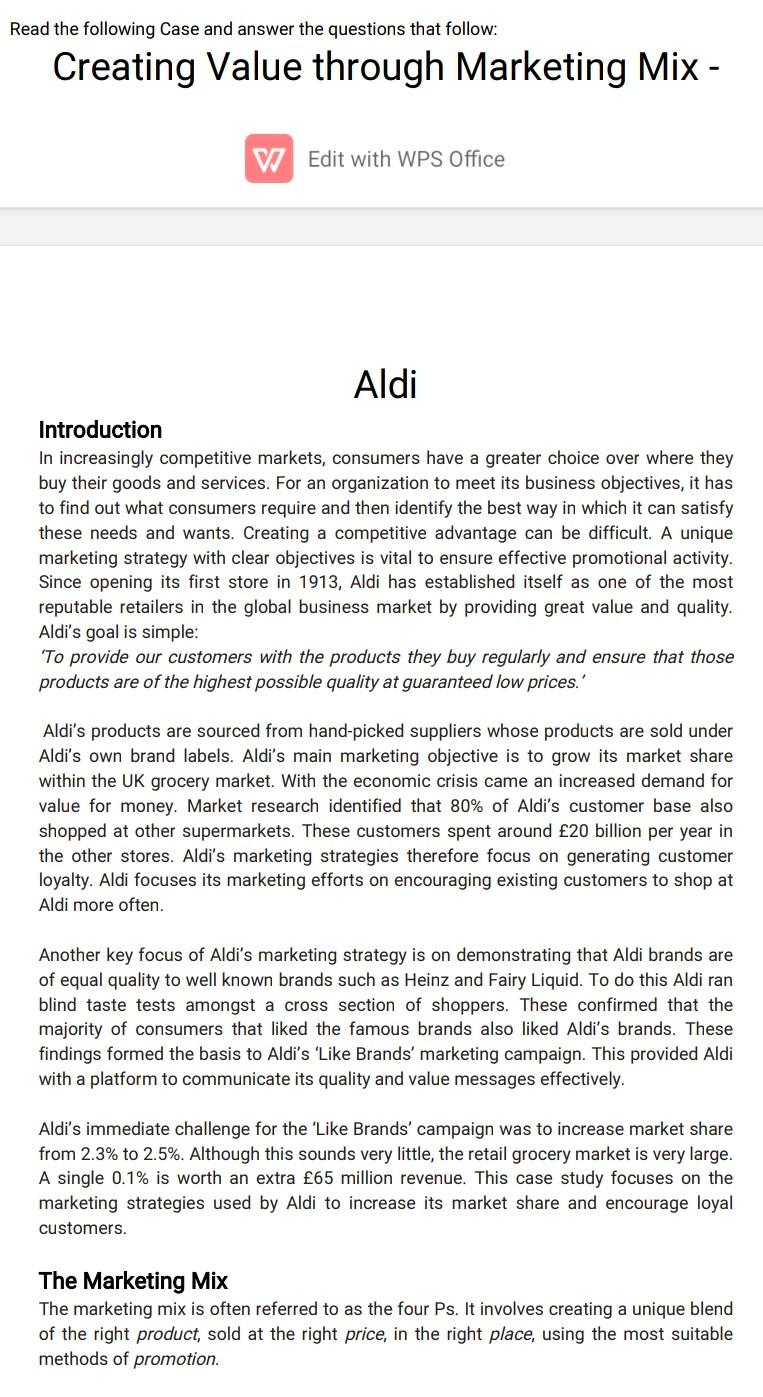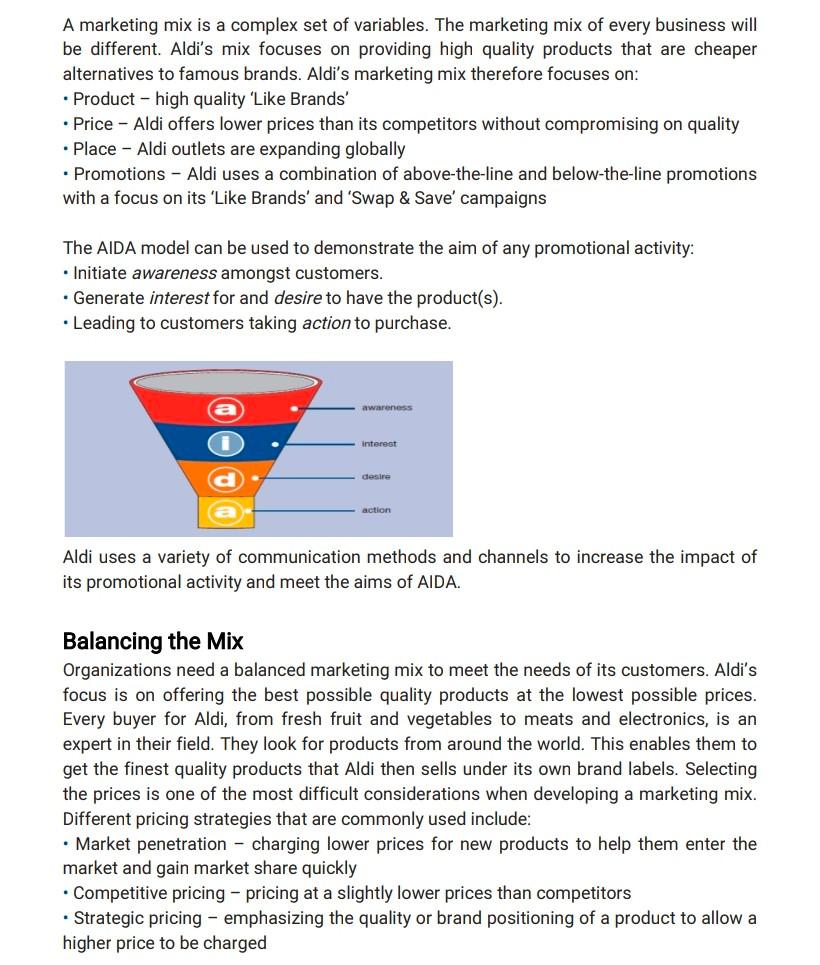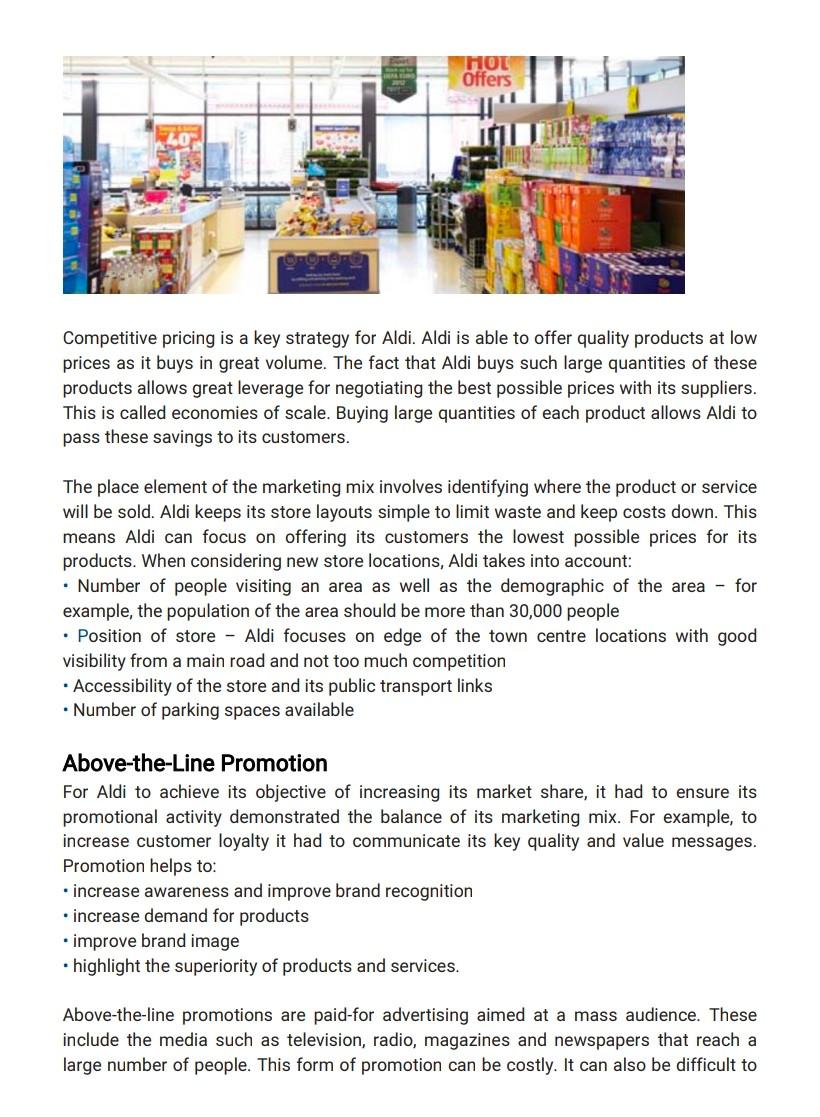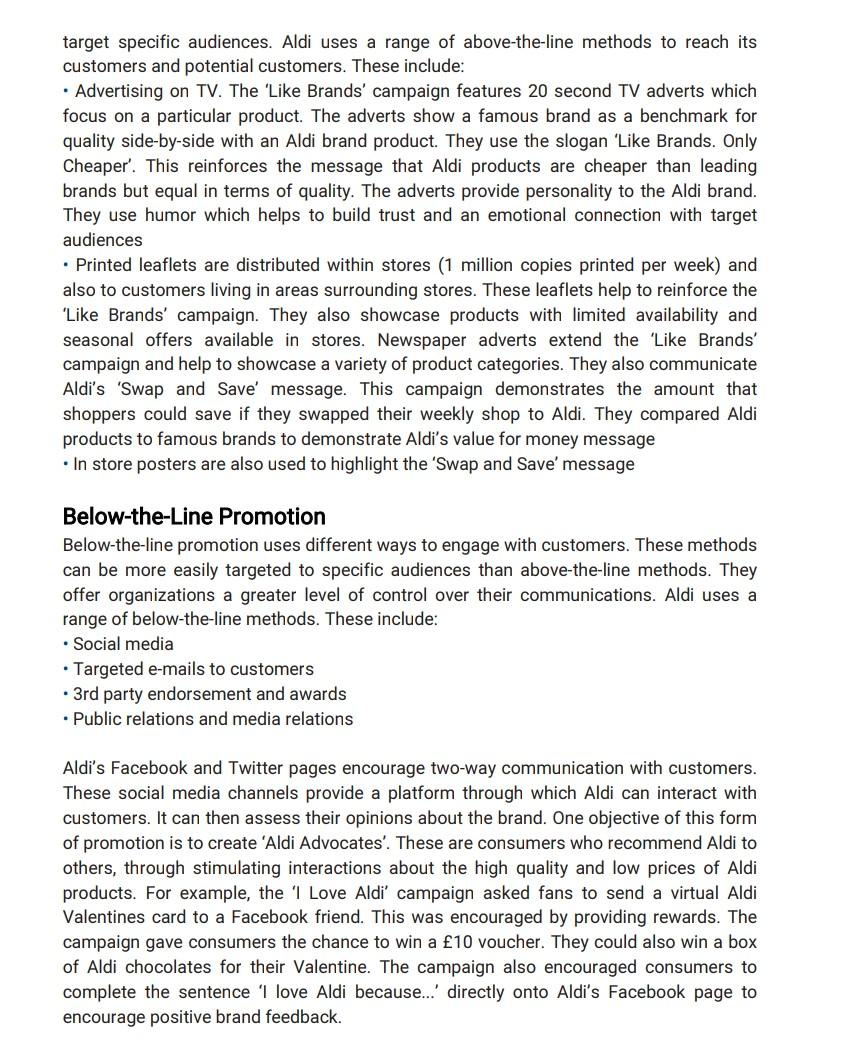Answered step by step
Verified Expert Solution
Question
1 Approved Answer
Evaluate how Aldi has identified a unique position within a competitive market place with the help of a balanced marketing mix. Read the following Case




Evaluate how Aldi has identified a unique position within a competitive market place with the help of a balanced marketing mix.
Read the following Case and answer the questions that follow: Creating Value through Marketing Mix - W Edit with WPS Office Aldi Introduction In increasingly competitive markets, consumers have a greater choice over where they buy their goods and services. For an organization to meet its business objectives, it has to find out what consumers require and then identify the best way in which it can satisfy these needs and wants. Creating a competitive advantage can be difficult. A unique marketing strategy with clear objectives is vital to ensure effective promotional activity. Since opening its first store in 1913, Aldi has established itself as one of the most reputable retailers in the global business market by providing great value and quality. Aldi's goal is simple: 'To provide our customers with the products they buy regularly and ensure that those products are of the highest possible quality at guaranteed low prices. Aldi's products are sourced from hand-picked suppliers whose products are sold under Aldi's own brand labels. Aldi's main marketing objective is to grow its market share within the UK grocery market. With the economic crisis came an increased demand for value for money. Market research identified that 80% of Aldi's customer base also shopped at other supermarkets. These customers spent around 20 billion per year in the other stores. Aldi's marketing strategies therefore focus on generating customer loyalty. Aldi focuses its marketing efforts on encouraging existing customers to shop at Aldi more often. Another key focus of Aldi's marketing strategy is on demonstrating that Aldi brands are of equal quality to well known brands such as Heinz and Fairy Liquid. To do this Aldi ran blind taste tests amongst a cross section of shoppers. These confirmed that the majority of consumers that liked the famous brands also liked Aldi's brands. These findings formed the basis to Aldi's 'Like Brands' marketing campaign. This provided Aldi with a platform to communicate its quality and value messages effectively. Aldi's immediate challenge for the 'Like Brands' campaign was to increase market share from 2.3% to 2.5%. Although this sounds very little, the retail grocery market is very large. A single 0.1% is worth an extra 65 million revenue. This case study focuses on the marketing strategies used by Aldi to increase its market share and encourage loyal customers. The Marketing Mix The marketing mix is often referred to as the four Ps. It involves creating a unique blend of the right product, sold at the right price, in the right place, using the most suitable methods of promotion. A marketing mix is a complex set of variables. The marketing mix of every business will be different. Aldi's mix focuses on providing high quality products that are cheaper alternatives to famous brands. Aldi's marketing mix therefore focuses on: Product - high quality 'Like Brands' Price - Aldi offers lower prices than its competitors without compromising on quality Place - Aldi outlets are expanding globally Promotions - Aldi uses a combination of above-the-line and below-the-line promotions with a focus on its 'Like Brands' and 'Swap & Save' campaigns The AIDA model can be used to demonstrate the aim of any promotional activity: Initiate awareness amongst customers. . Generate interest for and desire to have the product(s). Leading to customers taking action to purchase. awareness interest desire action Aldi uses a variety of communication methods and channels to increase the impact of its promotional activity and meet the aims of AIDA. Balancing the Mix Organizations need a balanced marketing mix to meet the needs of its customers. Aldi's focus is on offering the best possible quality products at the lowest possible prices. Every buyer for Aldi, from fresh fruit and vegetables to meats and electronics, is an expert in their field. They look for products from around the world. This enables them to get the finest quality products that Aldi then sells under its own brand labels. Selecting the prices is one of the most difficult considerations when developing a marketing mix. Different pricing strategies that are commonly used include: Market penetration - charging lower prices for new products to help them enter the market and gain market share quickly Competitive pricing - pricing at a slightly lower prices than competitors Strategic pricing - emphasizing the quality or brand positioning of a product to allow a higher price to be charged HOT Offers Competitive pricing is a key strategy for Aldi. Aldi is able to offer quality products at low prices as it buys in great volume. The fact that Aldi buys such large quantities of these products allows great leverage for negotiating the best possible prices with its suppliers. This is called economies of scale. Buying large quantities of each product allows Aldi to pass these savings to its customers. The place element of the marketing mix involves identifying where the product or service will be sold. Aldi keeps its store layouts simple to limit waste and keep costs down. This means Aldi can focus on offering its customers the lowest possible prices for its products. When considering new store locations, Aldi takes into account: Number of people visiting an area as well as the demographic of the area - for example, the population of the area should be more than 30,000 people Position of store - Aldi focuses on edge of the town centre locations with good visibility from a main road and not too much competition . Accessibility of the store and its public transport links Number of parking spaces available Above-the-Line Promotion For Aldi to achieve its objective of increasing its market share, it had to ensure its promotional activity demonstrated the balance of its marketing mix. For example, to increase customer loyalty it had to communicate its key quality and value messages. Promotion helps to: increase awareness and improve brand recognition increase demand for products . improve brand image highlight the superiority of products and services. Above-the-line promotions are paid-for advertising aimed at a mass audience. These include the media such as television, radio, magazines and newspapers that reach a large number of people. This form of promotion can be costly. It can also be difficult to target specific audiences. Aldi uses a range of above-the-line methods to reach its customers and potential customers. These include: Advertising on TV. The 'Like Brands' campaign features 20 second TV adverts which focus on a particular product. The adverts show a famous brand as a benchmark for quality side-by-side with an Aldi brand product. They use the slogan 'Like Brands. Only Cheaper'. This reinforces the message that Aldi products are cheaper than leading brands but equal in terms of quality. The adverts provide personality to the Aldi brand. They use humor which helps to build trust and an emotional connection with target audiences Printed leaflets are distributed within stores (1 million copies printed per week) and also to customers living in areas surrounding stores. These leaflets help to reinforce the 'Like Brands' campaign. They also showcase products with limited availability and seasonal offers available in stores. Newspaper adverts extend the 'Like Brands' campaign and help to showcase a variety of product categories. They also communicate Aldi's 'Swap and Save' message. This campaign demonstrates the amount that shoppers could save if they swapped their weekly shop to Aldi. They compared Aldi products to famous brands to demonstrate Aldi's value for money message In store posters are also used to highlight the 'Swap and Save' message Below-the-Line Promotion Below-the-line promotion uses different ways to engage with customers. These methods can be more easily targeted to specific audiences than above-the-line methods. They offer organizations a greater level of control over their communications. Aldi uses a range of below-the-line methods. These include: Social media . Targeted e-mails to customers 3rd party endorsement and awards Public relations and media relations Aldi's Facebook and Twitter pages encourage two-way communication with customers. These social media channels provide a platform through which Aldi can interact with customers. It can then assess their opinions about the brand. One objective of this form of promotion is to create 'Aldi Advocates'. These are consumers who recommend Aldi to others, through stimulating interactions about the high quality and low prices of Aldi products. For example, the 'I Love Aldi' campaign asked fans to send a virtual Aldi Valentines card to a Facebook friend. This was encouraged by providing rewards. The campaign gave consumers the chance to win a 10 voucher. They could also win a box of Aldi chocolates for their Valentine. The campaign also encouraged consumers to complete the sentence 'I love Aldi because...' directly onto Aldi's Facebook page to encourage positive brand feedbackStep by Step Solution
There are 3 Steps involved in it
Step: 1

Get Instant Access to Expert-Tailored Solutions
See step-by-step solutions with expert insights and AI powered tools for academic success
Step: 2

Step: 3

Ace Your Homework with AI
Get the answers you need in no time with our AI-driven, step-by-step assistance
Get Started


